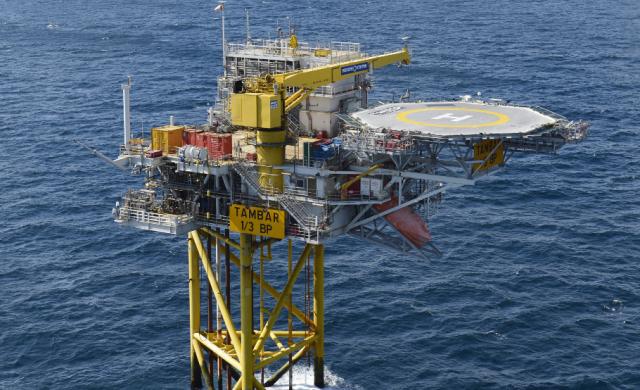
The BP-operated Tambar Field, 16 km southeast of Ula, Norway, is one of the handful of unmanned wellhead platforms operating offshore Norway. It is remotely controlled from Ula. (Source: BP)
When it comes to utilizing unmanned wellhead platforms (UWHP), Norway trails most others; however, a study released this month gives authorities and oil companies reason to consider putting the concept to use.
Commissioned by the Norwegian Petroleum Directorate (NPD), Rambøll Oil & Gas studied various unmanned wellhead platform concepts and determined that such platforms can be both cost- and production-effective development concepts particularly when used in shallow parts of the Norwegian Continental Shelf.
The Denmark-based engineering, design and consulting firm determined that a Type 3 minimalistic platform—which typically has between two and 12 wells and is designed to operate unmanned for as little as six months to as long as two years—is preferred for the Norwegian waters.
“As the concept is based on access by W2W [walk-to-work] bridges on a standby vessel or an offshore support rig, there should preferably be several UWHPs of this type in an area in order to distribute the operating costs of having [offshore service rigs] or W2W vessels in the area on more facilities, as the alternative would be to accept that the mobilization time could be fairly long,” the report said.
However, more complex reservoirs—such as those with frequent well intervention operations and major rotating equipment like downhole pumps—call for Type 0 or Type 1 platform, according to the report. Both are equipped with helidecks and cranes, and are designed to be operated unmanned for a few weeks. Unlike type 1 and 3 platforms, Type 0 platforms have fire, water and processing equipment and are most similar to manned platforms, according to the report.
The NPD called for the study of UWHPs as an alternative to subsea developments. The study, which provides Norway with insight on the advantages and disadvantages of the platforms, also comes as the oil and gas industry looks for ways to operate more efficiently and cost-effectively in a low commodity price environment.
“The overall experience shows that the amount of equipment and systems should be minimized and only highly reliable equipment and noble materials should be used, which will reduce capital expenditure (capex) as well as operational expenditures (opex),” according to the report.
In an October 2015 new release on the study, NPD principal engineer Niels Erik Hald said “it is just as functional and robust as a subsea development, and it is also more accessible for inspection and maintenance.”
With Type 3 platforms a closed circuit TV is usually used to monitor the platform and remote shutdowns can be carried out, as stated in the report. Wellhead control, emergency shutdown systems, fire and gas systems and SCADA systems are integrated. Should the platform’s fixed fire detection system signal a fire, fire water can be provided from the drilling rig, the report said. Primary evacuation is via the W2W bridge; otherwise, a fast rescue boat or a life raft are used.
Interest in unmanned installations has been growing. But their use on the NCS has been low—making up only 5% of the region’s 99 platforms—mainly because of water depth, field size, distance to infrastructure and regulatory requirements, the report said.
The percentage pales in comparison to other offshore areas, including the U.K. where, at 148, unmanned platforms account for 25% of the area’s platforms. More than half of the platforms in the Abu Dhabi/Middle Eastern waters use UWHPs, according to the report, which pointed out the Persian Gulf’s shallow water depths that make “rings of wellhead towers” unmanned around a central platform complex ideal.
However, Statoil and partners have decided to use an unmanned platform for its Oseberg Vestflanken 2 development, which will have 10 well slots. Located in the North Sea, the development has a water depth of about 110 m. Statoil—with partners Petoro, Total and ConocoPhillips—will drill two subsea wells from existing subsea templates as part of the project.
“Wellhead platforms with no facilities, helicopter deck or lifeboats represent a new solution in Norway, but it has been thoroughly tested in other areas such as the Danish and Dutch continental shelves,” Statoil said in a news release.
The study stated that unmanned platforms have been used offshore Denmark for more than three decades. All 14 of the Danish platforms used today are in shallow water. Depths range from 35 m to 70 m.
For the concept to take hold in Norway, regulatory guidelines or standards will be needed, the report said, noting that Norway’s existing regulations are geared toward manned platform.
Velda Addison can be reached at vaddison@hartenergy.com.
Recommended Reading
Treasury’s New Hydrogen Tax Credit Regs Open Door to NatGas Producers
2025-01-03 - The U.S. Treasury Department’s long awaited 45V hydrogen tax credit will enable “pathways for hydrogen produced using both electricity and methane” as well as nuclear, the department said Jan. 3.
BP Flows First Gas from Greater Tortue LNG Project
2025-01-03 - Once fully commissioned, Phase 1 of the Greater Tortue Ahmeyim LNG project led by operator BP is expected to produce approximately 2.3 MMtonne of LNG annually.
Former IPAA Chair Steven Hinchman Dies at 66
2025-01-03 - During his time with IPAA, Steven Hinchman founded Scala Energy and became its president and CEO.
NatGas in Storage Shows YOY Drop for First Time Since 2022
2025-01-03 - Despite a drop in gas in storage, prices took a hit from forecasts of warmer-than-expected weather.
Biden Blocks Japan’s Nippon Steel from Buying US Steel for $14.9B
2025-01-03 - President Biden cited national security concerns in his decision, but Nippon Steel and U.S. Steel said the decision ignored the law and was motivated by politics.
Comments
Add new comment
This conversation is moderated according to Hart Energy community rules. Please read the rules before joining the discussion. If you’re experiencing any technical problems, please contact our customer care team.





